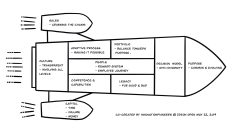Have you ever been talking about change for many years? Are you guilty of going on about change at the office or at dinner parties, or when others just wanted you to be quiet and listen? Is there a ”right way” to do change, or is it in such a chaotic stage that it’s pure luck when anyone succeeds?
Our theory illuminates how a Strategic Development Project flows through four different contexts along the way. In the beginning it’s very loose, just an idea or a thought that is contentious. If that thought infects the right person in a company, the idea becomes a thesis.
That thesis needs to be backed up and built into a project, a project that is a clear business impact and will help the company to rejuvenate its infrastructure. But before implementing the project it needs to get blessed and reshaped solution from the corporate authorities to fit in a new business organisation, based on a new paradigm. A new machine that has the possibility to produce something in a way that haven’t been done before.
Many years ago in Palo Alto, a local entrepreneur told a story that in some way inspired us to write Principles of Intrapreneurial Capital. The story was about the birth of San Fransisco which dates back to the mid 19th century when the town only had a couple of hundred residents.
The California Gold Rush had it first peak in 1849, and it only took a few years before the town developed into a city, with almost 40 000 inhabitants. These first pioneers of gold diggers were therefore called Forty-niners, now more widely known as the name of San Fransisco’s football team.There was a genuine interest for gold digging, so people came from everywhere with their dreams of getting rich and earning respect. Very few succeeded but some did.
The entrepreneur pointed out that there were generally two different techniques used in digging for gold: placer mining and hard rock mining. With the placer mining method, they used pans that they cradled using water to separate gold from the rocks around them. This method was used by most gold diggers and usually generated small chances of success, although a lot of gold was discovered this way in the California Gold Fever period.
The other method, hard rock mining, was a more industrialized way of extracting gold directly from a mountain. It needed two different roles in the gold digger profession: the gold seeker and the gold miner. When the gold seeker found a vein, the minier could start industrializing the extraction that would essentially continue for years.
At that point, the entrepreneur drew a parallel and said, “Well this is exactly what has happened to the incumbent companies. They have hit a vein and have perfected the methods of extracting that gold for centuries. And now when the vein is empty, they start to look around and they discover that all of the gold seekers are gone. They were not needed while the miners could extract the gold.”
Now the veins in many large established companies have dried out. How can they now relearn how to find gold again? Let’s discuss the what it takes to to rejuvenate your organization and empower your quest to find new veins.




